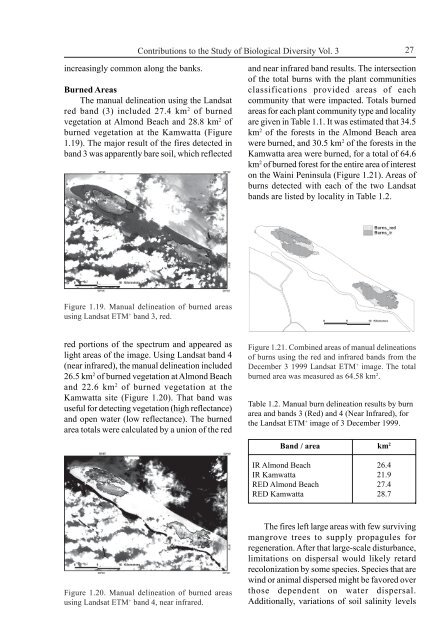Plant Community Structure, Fire Disturbance, and Recovery in ...
Plant Community Structure, Fire Disturbance, and Recovery in ...
Plant Community Structure, Fire Disturbance, and Recovery in ...
You also want an ePaper? Increase the reach of your titles
YUMPU automatically turns print PDFs into web optimized ePapers that Google loves.
<strong>in</strong>creas<strong>in</strong>gly common along the banks.<br />
Contributions to the Study of Biological Diversity Vol. 3<br />
Burned Areas<br />
The manual del<strong>in</strong>eation us<strong>in</strong>g the L<strong>and</strong>sat<br />
red b<strong>and</strong> (3) <strong>in</strong>cluded 27.4 km 2 of burned<br />
vegetation at Almond Beach <strong>and</strong> 28.8 km 2 of<br />
burned vegetation at the Kamwatta (Figure<br />
1.19). The major result of the fires detected <strong>in</strong><br />
b<strong>and</strong> 3 was apparently bare soil, which reflected<br />
Figure 1.19. Manual del<strong>in</strong>eation of burned areas<br />
us<strong>in</strong>g L<strong>and</strong>sat ETM + b<strong>and</strong> 3, red.<br />
red portions of the spectrum <strong>and</strong> appeared as<br />
light areas of the image. Us<strong>in</strong>g L<strong>and</strong>sat b<strong>and</strong> 4<br />
(near <strong>in</strong>frared), the manual del<strong>in</strong>eation <strong>in</strong>cluded<br />
26.5 km 2 of burned vegetation at Almond Beach<br />
<strong>and</strong> 22.6 km 2 of burned vegetation at the<br />
Kamwatta site (Figure 1.20). That b<strong>and</strong> was<br />
useful for detect<strong>in</strong>g vegetation (high reflectance)<br />
<strong>and</strong> open water (low reflectance). The burned<br />
area totals were calculated by a union of the red<br />
Figure 1.20. Manual del<strong>in</strong>eation of burned areas<br />
us<strong>in</strong>g L<strong>and</strong>sat ETM + b<strong>and</strong> 4, near <strong>in</strong>frared.<br />
27<br />
<strong>and</strong> near <strong>in</strong>frared b<strong>and</strong> results. The <strong>in</strong>tersection<br />
of the total burns with the plant communities<br />
classifications provided areas of each<br />
community that were impacted. Totals burned<br />
areas for each plant community type <strong>and</strong> locality<br />
are given <strong>in</strong> Table 1.1. It was estimated that 34.5<br />
km 2 of the forests <strong>in</strong> the Almond Beach area<br />
were burned, <strong>and</strong> 30.5 km 2 of the forests <strong>in</strong> the<br />
Kamwatta area were burned, for a total of 64.6<br />
km 2 of burned forest for the entire area of <strong>in</strong>terest<br />
on the Wa<strong>in</strong>i Pen<strong>in</strong>sula (Figure 1.21). Areas of<br />
burns detected with each of the two L<strong>and</strong>sat<br />
b<strong>and</strong>s are listed by locality <strong>in</strong> Table 1.2.<br />
Figure 1.21. Comb<strong>in</strong>ed areas of manual del<strong>in</strong>eations<br />
of burns us<strong>in</strong>g the red <strong>and</strong> <strong>in</strong>frared b<strong>and</strong>s from the<br />
December 3 1999 L<strong>and</strong>sat ETM + image. The total<br />
burned area was measured as 64.58 km 2 .<br />
Table 1.2. Manual burn del<strong>in</strong>eation results by burn<br />
area <strong>and</strong> b<strong>and</strong>s 3 (Red) <strong>and</strong> 4 (Near Infrared), for<br />
the L<strong>and</strong>sat ETM + image of 3 December 1999.<br />
B<strong>and</strong> / area<br />
IR Almond Beach<br />
IR Kamwatta<br />
RED Almond Beach<br />
RED Kamwatta<br />
km 2<br />
26.4<br />
21.9<br />
27.4<br />
28.7<br />
The fires left large areas with few surviv<strong>in</strong>g<br />
mangrove trees to supply propagules for<br />
regeneration. After that large-scale disturbance,<br />
limitations on dispersal would likely retard<br />
recolonization by some species. Species that are<br />
w<strong>in</strong>d or animal dispersed might be favored over<br />
those dependent on water dispersal.<br />
Additionally, variations of soil sal<strong>in</strong>ity levels
















